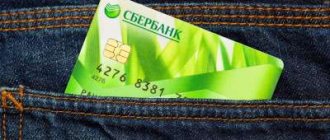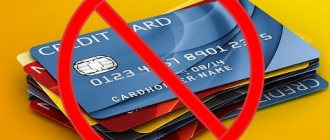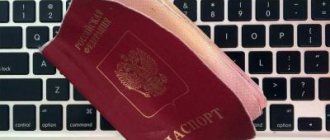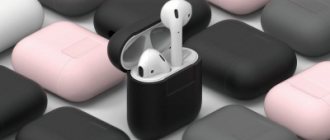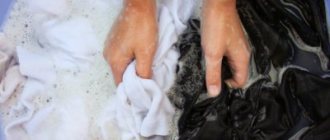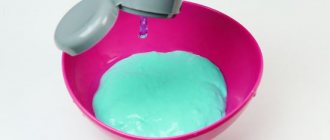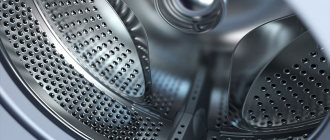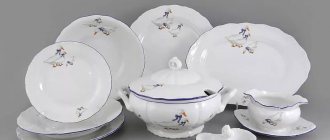Violating the basic rules for preparing clothes for washing (namely, ignoring recommendations about pre-checking pockets) leads to an unpleasant situation.
This causes the unexpected discovery of paper money or coins in the washing machine.
What to do if you washed money in a washing machine, how to dry it, is it possible to change washed banknotes, for example, at Sberbank? Find answers to these questions in the article.
How to revive washed dollars or euros from mold
Sometimes mold appears on money that is washed and dried afterwards. Dollars and euros are especially susceptible to this. It is necessary to get rid of fungal infection using the following methods.
- Place the bills in the oven at 120 degrees. Under the influence of high temperature, mold will be destroyed.
- Detergents that contain bleach. Effectively removes Fairy mold. Apply a little onto the money and wipe with a damp cloth.
- Place the bills in a pillowcase and wash in the washing machine. Afterwards, iron it.
Such methods do not provide a 100% guarantee, since the fungus can penetrate into the very structure of the paper fibers. Thanks to the described methods, a minimal amount of mold can be eliminated.
Effective methods for restoring the original appearance of washed banknotes
It is important to process washed money correctly. There are several ways to help restore the normal appearance of paper bills and coins. They involve drying and eliminating the smell of mold.
How to dry it properly?
The most common method is drying between clean sheets of paper. To this end, you should perform the following steps:
First, carefully lay the banknotes on a terry towel and cover the top with another towel or soft rag. This will remove most of the moisture.- After this procedure, each bill should be carefully spread out on a sheet of paper, covering the top with the same one.
- Place a book on top of the second sheet (to prevent deformation of the banknote).
- As the paper sheets become damp, they should be replaced with new ones until the money is completely dry.
The method is quite effective, but time-consuming. There are other equally effective measures to restore washed money.
Iron drying
It is recommended to dry money while smoothing it with an iron on an ironing board. The algorithm of actions is as follows:
- lay down a clean soft cloth, carefully placing wet bills on it;
- cover the top with the same fabric;
- Having set the iron to the minimum temperature setting for any type of fabric (cotton, wool, synthetics), you should carefully iron the fabric surface until it is completely dry and the paper money is restored.
Drying coins is much easier. They must be rinsed under running water and laid out in one layer on a soft cloth.
Drying with a hairdryer
You will have to hold the banknote with one hand and direct the warm jet of a hairdryer onto it with the other . Using hot air will dry the money paper quickly, but forced drying often results in warping.
Before such drying, preliminary preparation will also be required, including removing moisture with a towel. This procedure is described above.
On a rope
This method will also give positive results for drying banknotes. But it has disadvantages:
- the use of clothespins will cause the ends of the banknote to break;
- when suspended, banknotes curl and become deformed;
- In the end, you will still have to resort to using an iron.
Of the methods described above, ironing washed money is the fastest and most effective. After this procedure, they will acquire their original condition and payment status.
How will washing affect their condition?
Most often, money that has suffered from mechanical stress when washing clothes does not lose its solvency.
What can happen to paper banknotes?
Washed banknotes naturally lose their original appearance after washing . However, they retain their payment status.
This is due to the use of special paper and special durable paint for their manufacture, which provide the money with sufficiently high strength.
Their usual appearance may change if:
- bleach was used for washing, which will cause the paint on paper bills to fade slightly;
- the washing powder contained chlorine or aggressive components to remove stains;
- clothes could fade, causing paper money to take on an unusual color.
The appearance of paper money remains virtually unchanged if it remains in your pocket during the washing process.
This eliminates the possibility of their deformation and transformation into torn fragments. Even in case of damage and rupture, serial numbers are retained , which allows you to restore the value of banknotes by contacting banking institutions.
What will happen to the coins?
Finding coins in the drum after washing is fraught with consequences not so much for metal money as for the washing machine.
Small items may damage the drum. Therefore, coins must be found and removed to avoid repeated negative impact on the inner lining of the drum.
It is recommended to do the following:
- Rotate the drum by hand, inspect and feel its inner surface.
- Check to see if coins are stuck in the rubber seal, that is, in the hatch cuff.
- Inspect the drain pump filter. It is located at the bottom of the machine body. This is a small panel equipped with a protective cover. You need to open it by scrolling counterclockwise and remove the coins, if there are any.
Metal money may be slightly deformed and nothing more. In addition, they will have an unpleasant odor.
Fan installation
Place a fan near your desk. Install this equipment at such a distance that the air flow it produces will not subsequently blow money off the table.
First, lay out several thick paper napkins on the table surface. Place the wet bills themselves on top of them. Carefully cover each banknote on top with another napkin. Turn on the fan at the lowest speed.
Using an iron
This method is perfect for drying not too many bills. Ironing each banknote separately in this case will most likely not take too much time. To dry using this method, first lay the first bill on the ironing board and straighten it out well. Adjust the iron to minimum heat and plug it in. Check to see if the sole is too hot.
Gently iron the bill using forward/backward movements for several seconds. Turn the banknote over on the board and repeat the operation. Wait a while for the bill to cool and iron it again on both sides. Continue drying the note until all moisture has evaporated. It usually takes about 30-60 seconds to dry one bill. But if the banknote is very wet, it will most likely take a little longer to iron it.
Colleagues keep their distance from you: disadvantages of being the boss's favorite in the office
Don’t say, “I’m right, but you’re wrong!”: tips on how to resolve conflict at work
Read at three in the morning and more: unique habits of the most successful people
If you washed your passport
If your passport has been washed, you need to check its condition. Replace the document if:
- all the inscriptions are erased, blurred, nothing can be read;
- it's torn.
How to restore your passport at home:
- Open the document, flip through and stick out all the pages.
- Replace the pages with white sheets and leave to dry.
Attention! You cannot dry your passport on a radiator. It will become deformed and will be impossible to restore.
- Change the sheets periodically as soon as they become saturated with moisture.
- When the document is dry, place the press on top.
As a result, your document is valid. You will be able to use it as before. But government agencies may advise you to replace your passport. If all inscriptions, seals and signs are clearly visible, then the law does not provide for a mandatory replacement of the document; this is your personal matter. The situation is different with a truly damaged document. It is necessary to replace it, and you will have to pay a fine.
According to the Code of Administrative Offenses of the Russian Federation, damage to a document due to negligence and the impossibility of restoring it are punishable by a fine of 100 to 300 rubles or an administrative warning.
Replacing a document
What you need to consider to quickly replace your passport:
- Fill out a statement about damage or loss of a document according to the 1P model.
- Apply to the Migration Service at your place of registration. If you are registered at your place of residence, the waiting period will be about 10 days. If you do not live at your place of registration, you will have to wait up to 2 months.
- Show your old document.
- Take two photos.
- Bring a receipt for payment of the state fee (about 1,500 rubles).
- Provide a birth or marriage certificate or other documents. All the data that must be included in the passport is required.
An application for a replacement document can be submitted online on the Internet. Then you won't have to stand in line.
When receiving a new document, be sure to check the data.
What happens to the money after washing it in the washing machine?
The banknotes are quite durable, made of linen, cotton and soaked in gelatin. With normal cash flow, they last 2-3 years. If money accidentally gets into the washing machine, it most often remains intact, but it can become wrinkled and change color. With the maximum washing mode, there is a risk that the money will be torn. Such bills will not be accepted in stores or transport. Here it is better to immediately contact the bank for an exchange.
Handwritten recovery of banknotes
If you washed dollars or other banknotes in a washing machine and they have not lost their appearance, you can try to “reanimate” them yourself.
How to dry money quickly? The best option is to use an iron.
What to do? Need to:
- Take two sheets of clean paper or 2 pieces of gauze, folded into 3-4 layers.
- Place one under the bottom of the bill, the second on top.
- Turn on the iron at medium power.
- Iron the workpiece.
Afterwards the money will level out, dry out and you can use it to pay.
If the iron suddenly malfunctions, you can try drying the banknotes with a hairdryer and straightening them under a press. Place the money on paper on a flat surface, press it down with books on top and leave it for a while. Then dry with a hairdryer.
Drying banknotes can be done in other ways, but here the money will remain wrinkled. You can continue to align banknotes without problems in the future.
To allow the bills to dry, place them:
- in the sun in a windless place;
- in the oven at low temperature;
- on the battery (it is advisable to place a sheet of paper underneath);
- near the heater;
- near the stove or fireplace.
Young girls manage to dry and straighten banknotes with hair straighteners, which is no less effective. Paper money dries instantly and is immediately flattened. But in order not to burn the bill, you should put it in paper. This express method is reminiscent of iron drying.
Even if you just put the money in the room after washing, it will dry. Only in time it will drag on for a longer period.
Sometimes, when exposed to ultraviolet light, a specific spotting may appear on banknotes - this is a fungus. Such damage is more common on foreign currency. It becomes the reason for refusing to accept banknotes. Mold can appear after poor drying or when storing money in dampness or cellophane. From infected dollars, the fungus quickly spreads to neighboring ones. You can remove such stains using:
- Oven. A temperature of 110-120 degrees effectively eliminates the problem.
- Gel-based detergents. The best option is Fairy.
Any dirt can be removed with a regular soap solution. Afterwards, the banknotes are dried using one of the above methods.
What should I do if my money breaks after being washed in the washing machine? If the bill is torn in half, then there are two options: glue it together or contact the bank for an exchange.
Gluing will help, but it is not a fact that such money will be accepted. Failure will follow in case of careless gluing. Especially if tape was used. Small denomination bills are sometimes accepted, but large ones are not.
If a small part of the bill comes off or there is a tear, you can coat the damaged area with PVA glue and press it. This type of repair can recover money without anyone noticing.
How to seal a torn banknote yourself and is it worth doing?
Experts recommend that you immediately return the torn banknote to the bank for exchange. The procedure is simple and does not require financial costs on the part of the client. However, not everyone agrees to spend time on this.
Many people cover a torn banknote with tape, but this looks rude and not aesthetically pleasing. Such money may not be accepted in stores, and self-service terminals will “spit” it back. You can glue a torn banknote in several ways, for example, with PVA glue.
To do this you will need:
- glass bottle, jar or wax paper;
- PVA glue;
- iron.
What to do if a banknote is torn:
- A thin layer of glue is applied to the tear site. This can be done using a toothpick, knitting needle or match.
- The halves of the banknote are placed end-to-end on a bottle or paper, matching the pattern. There should be no overlap when joining.
- A hot iron is passed over the joint several times and allowed to cool.
You can also glue a damaged banknote using a glue stick:
- To do this, apply glue along the ends, let it dry and apply it again.
- Then the torn parts are placed on wax paper, carefully adjusting the design.
- Talc or starch is applied to the joint to avoid gluing with other bills.
- The banknote is allowed to dry for half an hour.
Office supply stores also sell special adhesive tape for repairing damaged money. Unlike ordinary stationery tape, it is invisible after gluing.
Replacing money
As already mentioned, banknotes can usually be washed without much harm to themselves. In addition, according to current legislation in Russia, stores are required to accept dried and even slightly damaged banknotes from customers.
But unfortunately, sometimes it happens that due to moisture, money becomes completely unusable. This can happen in a typewriter, for example, with an old bill. Also, the banknote will most likely be damaged if it remains in water for too long. In such a situation, the only way to solve the problem is, of course, to go to the bank to replace the banknote.
Is it possible to exchange the currency of another country?
Most often, Russians have to dry their clothes after washing, of course, in our domestic rubles. However, of course, due to carelessness, you can wash dollars or, for example, euros in a machine. Foreign currency can be dried using the same methods as domestic currency. If desired, such money can be placed under a fan or ironed. But what to do if the dollar or euro was seriously damaged during washing?
Such a banknote can also be exchanged directly on the territory of Russia. However, unfortunately, not all banks exchange foreign currencies in our country. Therefore, if necessary, first look online for a branch that is guaranteed to provide such a service. In any case, when exchanging a banknote from another country, you will most likely have to pay a commission of 3-10% of its face value.
Found a violation? Report content
I washed money in the washing machine, what should I do?
Washed your phone, money, passport in the washing machine - how to fix it
Equipment manufacturers always warn that pockets should be checked and cleaned before washing. Unfortunately, not everything happens according to the rules. What to do if you washed your phone in the washing machine, or the money in your pocket got wet?
It is important to know how to return items to their original appearance without wasting a minute of time.
Equipment manufacturers always warn that pockets should be checked and cleaned before washing. Unfortunately, not everything happens according to the rules. What to do if you washed your phone in the washing machine, or the money in your pocket got wet?
Washed banknotes in a washing machine
Money is made from special paper on which special paint is applied, so it is not easy to damage it.
Hence, you can exchange them at your nearest bank branch.
If a small corner is missing
A banknote that has lost a small corner does not lose its solvency - you can pay with this money in a store. If they refuse to accept them for payment, then it’s time to remind about your rights and refer to the Bank of Russia’s directive No. 1778-U dated December 26, 2006 “On the signs of solvency and rules for the exchange of banknotes and coins of the Bank of Russia.” The document clearly and in detail states which banknotes are full-fledged means of payment. These include torn, worn, punctured, frayed, written on and soiled bills. In addition, banknotes with small holes, as well as those with torn edges, are recognized as valid. Banknotes with minor damage, but with images preserved on them, are considered solvent.
If a more significant piece or fragment with part of the banknote number is lost, then feel free to take it to the nearest bank branch. Note - any bank, and not just the one where you have an account. The bank will exchange substandard banknotes for new ones without requiring your passport or charging a commission. If the amount exceeds 15,000 rubles, then a passport will be required.
If there is no corner, the banknote is replaced immediately after acceptance. But there are times when you have to wait - first the accepted banknote will be sent for examination to the Central Bank.
Can I change it at Sberbank?
If the store refuses to accept washed and restored money, you should contact any bank, for example Sberbank, to exchange it.
According to the Regulation adopted by the Bank of Russia on December 26, 2006 No. 1778-U,
banknotes with minor damage are considered solvent and subject to exchange:
- having spots;
- those that have lost their original color (faded or stained fabrics during molting);
- worn, wrinkled, deformed;
- torn or lost edges and corners.
Such money is exchanged in all Russian banks without any payment and in the monetary equivalent corresponding to the previous denomination. Exchange operations are carried out not only by government institutions, but also by commercial institutions.
Banks even exchange torn banknotes that have retained at least 50% of the original size. In addition, banknotes glued together from several fragments are subject to exchange.
In this case, the following criteria for the validity of the banknote are taken into account:
- parts must belong to one banknote of the same denomination;
- each part of damaged money must be 50% of the initial area;
- bills glued together from several fragments must retain 50% of the area in at least one of the parts.
An important condition for exchanging money damaged by washing is to preserve the number, series and banknote certifying their nominal value.
Metal money that is deformed or has changed its original color after washing is also exchanged. The main thing is that information about belonging to Russian coins and nominal features are preserved. As for the remaining area, it should be at least 70% of the previous volume.
The algorithm for contacting a bank involves submitting an application to exchange damaged money and providing an identification document, that is, a passport.
After assessing the condition of the banknotes, the client will be exchanged in full for solvent banknotes. There are no restrictions on the amount required for exchange.
Nuances of exchanging damaged foreign currency
The bank will only replace banknotes that have not undergone significant damage that has changed their appearance.
Worn and faded dollars can be exchanged subject to a commission fee of 3–10% of their total value.
At the same time, the number, series and denomination of the banknote must be clearly visible on banknotes .
You will find maximum useful information about washing clothes and various fabric products here.
What to do if the bank refuses to exchange money
If the banknote cannot be exchanged for one of the reasons stated above, the bank employee will return it to you with the appropriate note. In this case, try contacting another bank.
Virgos are masters of planning: which zodiac signs hate change They think this is the only way to wealth: why people don’t invest Undivided attention to family: 4 problems that cause stress for entrepreneurs
If money is also not accepted at another branch, try writing a corresponding statement on the Central Bank website. Next, wait for an answer and do what the specialist advises you.
You may have to send the damaged bill for examination. In this case, first dry the banknote, then line it with napkins and only then place it in the convention.
Important!
Drying banknotes with an iron usually takes quite a long time. You may be tempted to turn up the heat on the soleplate. Do not do this under any circumstances. Burning paper with an iron is actually very simple.
For the same reason, do not place the iron on a banknote to hold it there for a while. In this case, it will also be very easy to burn money. Be sure to move the iron back and forth while drying so that different parts of the bill are periodically exposed to you. This way you can control the situation.
If your iron gets too hot even on the lowest setting, iron the bills through a clean cloth. However, do not hold the iron over the banknote for a long time.
Air drying process
Wait a while and check the bills. If the wipes are heavily saturated with water, replace them with new ones. Next, turn the bills over to the other side up every half hour. This will allow you to dry evenly and ultimately get even, unwarped bills.
She and her husband donate millions to charity: how much is Blake Lively “worth”
British food giant Danone buys shares in UK mineral no.
Where to stay in Sorrento: the best options for budget accommodation
If you have time, use a hair dryer instead of a fan. In this case, also first place the bill on a napkin. Next, blow the banknote with a hairdryer, turning it over from time to time.
Helpful advice
Sometimes it happens that there is neither a fan nor a hairdryer at hand. In this case, simply place the bills on napkins, one at a time, on the table next to the window so that the money receives direct sunlight. Next, simply leave the banknotes to dry for a while.
Drying banknotes in the sun, of course, will take a little longer than using a hairdryer or fan. In any case, when using this technique, the drying procedure will most likely take at least 2-4 hours, depending on how much moisture the paper has managed to absorb.
